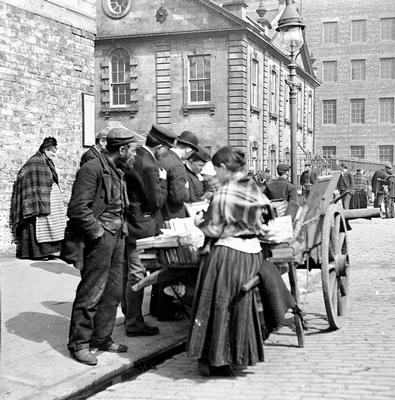
A book barrow in Greendyke Street c 1916. Glasgow's street traders would hire their barrows at an hourly, daily or weekly rate and take them to a regular pitch or push them through the streets to expose their wares to potential customers.
The introduction of compulsory education in 1872 for all children aged between 6 and 12 years greatly improved working class literacy in Scotland. There was a long and proud tradition in the country of opening libraries to provide "improving" literature to working men, but increased literacy after 1872 prompted a greater demand for novels and magazines.
The browsers at this barrow include what appear to be a smartly-dressed middle-class couple (the man in his bowler hat), and a labourer in a flat cap (or "bunnet"). The woman on the left is dressed in traditional 19th century working-class Glasgow style, in apron and shawl.
Reference: 55.79.1
Reproduced with the permission of Glasgow City Council, Glasgow Museums
Keywords:
aprons, barrows, books, booksellers, bowler hats, bunnets, caps, fashions, labourers, reading, second-hand books, shawls, stalls, street traders, streetscenes, women
You have 0 images in your photo album.